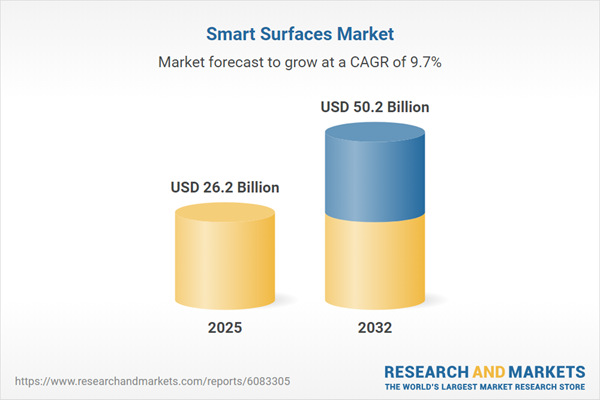Speak directly to the analyst to clarify any post sales queries you may have.
The smart surfaces market is at the forefront of transforming industrial and commercial environments by merging advanced materials with digital and sustainability imperatives. Senior leaders are increasingly leveraging these innovations to meet evolving performance and operational demands.
Market Snapshot: Smart Surfaces Market Growth and Outlook
The Smart Surfaces Market grew from USD 23.92 billion in 2024 to USD 26.20 billion in 2025. It is expected to continue growing at a CAGR of 9.70%, reaching USD 50.20 billion by 2032. This expansion reflects rising adoption across industries such as automotive, construction, healthcare, and electronics, as smart coatings, sensors, and adaptive materials address complex challenges and sustainability objectives. Key adoption drivers include regulatory compliance, digitization trends, and the ongoing push for operational efficiency.
Scope & Segmentation of the Smart Surfaces Market
This report offers a comprehensive view of the smart surfaces market, covering multiple material types, functionalities, end-use applications, and geographical regions.
- Material Types: Hydrogels, nanomaterials, smart ceramics, smart coatings, smart glass, smart metals, smart polymers
- Functions: Anti-bacterial action, anti-fog treatment, anti-reflection enhancements, self-cleaning properties
- Key Applications: Automotive (exterior, interior), building and construction (facades, roofs, walls, windows), electronics and optoelectronics (displays, sensors, smart cards), healthcare and medical (diagnostic devices, hospital surfaces, surgical tools)
- Regions Covered: Americas (North America, Latin America), Europe, Middle East & Africa, Asia-Pacific
- Major Players: AGC Inc., Compagnie de Saint-Gobain, 3M Company, Nippon Sheet Glass Co., Ltd., DuPont de Nemours, Inc., Covestro AG, Akzo Nobel N.V., BASF SE, Dow Inc., Evonik Industries AG
Key Takeaways for Senior Decision-Makers
- Smart surfaces are rapidly moving from pilot projects to mainstream adoption, largely driven by environmental regulations and the need for operational efficiencies.
- Cross-functional collaboration between material scientists, manufacturers, and end-users accelerates time-to-market for application-driven innovations.
- Next-generation materials enhance energy management, improve hygiene, and offer tailored performance in industries unable to compromise on safety or reliability.
- Emerging supply chain strategies, particularly nearshoring and sourcing diversification, have become central to managing costs and mitigating trade disruptions.
- Sectors such as healthcare and automotive are leading with advanced functionalities like antimicrobial coatings and adaptive glass panels that meet evolving consumer and regulatory expectations.
- Regional differences in adoption stem from varied regulatory frameworks, resource access, and the presence of industry clusters focused on rapid commercialization.
Tariff Impact: Supply Chain and Cost Implications
Recent tariff adjustments in the United States have reshaped smart surface supply chains. Increased duties on key input materials have prompted manufacturers to reconfigure sourcing and production strategies. These conditions are accelerating the shift to domestic partners and encouraging the use of innovative alternatives such as nanomaterials or hydrogels produced regionally. As a result, companies are recalibrating procurement and logistics approaches while intensifying efforts to boost resilience and maintain consistent quality standards.
Methodology & Data Sources
This report applies a multi-stage methodology, collecting secondary data from technical literature, patents, and regulatory documents. Primary interviews with industry leaders and experts validate emerging trends and challenges. Data triangulation and analytical techniques, such as thematic coding and cluster analysis, ensure findings are robust, accurate, and actionable for strategic planning purposes.
Why This Report Matters
- Aligns material technology, functional demands, and regional variables to inform high-impact strategic decisions.
- Enables risk mitigation through clarity on supply chain, regulatory, and market trends affecting procurement and innovation roadmaps.
- Guides R&D investment and product development strategies by highlighting evolving end-user applications and collaborative opportunities.
Conclusion
The smart surfaces market is defined by material innovation, regulatory change, and evolving industry requirements, offering leaders actionable insight on future opportunities. Strategic adoption of smart surfaces can drive enhanced performance and sustained market relevance.
Table of Contents
3. Executive Summary
4. Market Overview
7. Cumulative Impact of Artificial Intelligence 2025
Companies Mentioned
The companies profiled in this Smart Surfaces market report include:- AGC Inc.
- Compagnie de Saint-Gobain
- 3M Company
- Nippon Sheet Glass Co., Ltd.
- DuPont de Nemours, Inc.
- Covestro AG
- Akzo Nobel N.V.
- BASF SE
- Dow Inc.
- Evonik Industries AG
Table Information
| Report Attribute | Details |
|---|---|
| No. of Pages | 184 |
| Published | November 2025 |
| Forecast Period | 2025 - 2032 |
| Estimated Market Value ( USD | $ 26.2 Billion |
| Forecasted Market Value ( USD | $ 50.2 Billion |
| Compound Annual Growth Rate | 9.7% |
| Regions Covered | Global |
| No. of Companies Mentioned | 11 |









